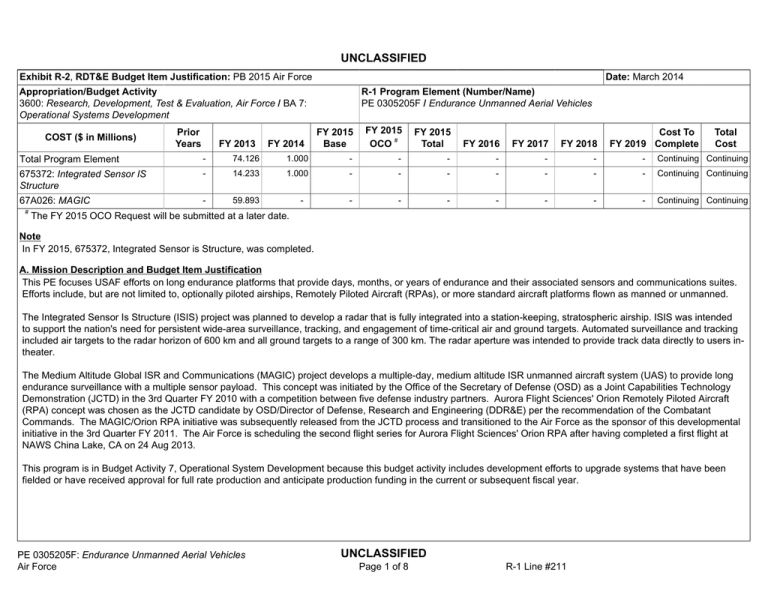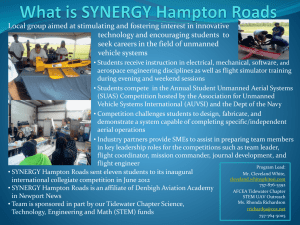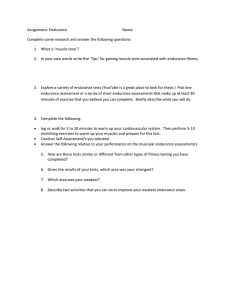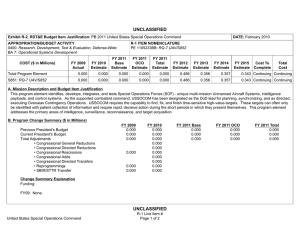UNCLASSIFIED
advertisement

UNCLASSIFIED Date: March 2014 Exhibit R-2, RDT&E Budget Item Justification: PB 2015 Air Force Appropriation/Budget Activity 3600: Research, Development, Test & Evaluation, Air Force / BA 7: Operational Systems Development COST ($ in Millions) Prior Years FY 2013 FY 2014 R-1 Program Element (Number/Name) PE 0305205F / Endurance Unmanned Aerial Vehicles FY 2015 Base FY 2015 # OCO FY 2015 Total FY 2016 FY 2017 FY 2018 Cost To FY 2019 Complete Total Cost Total Program Element - 74.126 1.000 - - - - - - - Continuing Continuing 675372: Integrated Sensor IS Structure - 14.233 1.000 - - - - - - - Continuing Continuing 67A026: MAGIC - 59.893 - - - - - - - - Continuing Continuing # The FY 2015 OCO Request will be submitted at a later date. Note In FY 2015, 675372, Integrated Sensor is Structure, was completed. A. Mission Description and Budget Item Justification This PE focuses USAF efforts on long endurance platforms that provide days, months, or years of endurance and their associated sensors and communications suites. Efforts include, but are not limited to, optionally piloted airships, Remotely Piloted Aircraft (RPAs), or more standard aircraft platforms flown as manned or unmanned. The Integrated Sensor Is Structure (ISIS) project was planned to develop a radar that is fully integrated into a station-keeping, stratospheric airship. ISIS was intended to support the nation's need for persistent wide-area surveillance, tracking, and engagement of time-critical air and ground targets. Automated surveillance and tracking included air targets to the radar horizon of 600 km and all ground targets to a range of 300 km. The radar aperture was intended to provide track data directly to users intheater. The Medium Altitude Global ISR and Communications (MAGIC) project develops a multiple-day, medium altitude ISR unmanned aircraft system (UAS) to provide long endurance surveillance with a multiple sensor payload. This concept was initiated by the Office of the Secretary of Defense (OSD) as a Joint Capabilities Technology Demonstration (JCTD) in the 3rd Quarter FY 2010 with a competition between five defense industry partners. Aurora Flight Sciences' Orion Remotely Piloted Aircraft (RPA) concept was chosen as the JCTD candidate by OSD/Director of Defense, Research and Engineering (DDR&E) per the recommendation of the Combatant Commands. The MAGIC/Orion RPA initiative was subsequently released from the JCTD process and transitioned to the Air Force as the sponsor of this developmental initiative in the 3rd Quarter FY 2011. The Air Force is scheduling the second flight series for Aurora Flight Sciences' Orion RPA after having completed a first flight at NAWS China Lake, CA on 24 Aug 2013. This program is in Budget Activity 7, Operational System Development because this budget activity includes development efforts to upgrade systems that have been fielded or have received approval for full rate production and anticipate production funding in the current or subsequent fiscal year. PE 0305205F: Endurance Unmanned Aerial Vehicles Air Force UNCLASSIFIED Page 1 of 8 R-1 Line #211 UNCLASSIFIED Date: March 2014 Exhibit R-2, RDT&E Budget Item Justification: PB 2015 Air Force Appropriation/Budget Activity 3600: Research, Development, Test & Evaluation, Air Force / BA 7: Operational Systems Development B. Program Change Summary ($ in Millions) Previous President's Budget Current President's Budget Total Adjustments • Congressional General Reductions • Congressional Directed Reductions • Congressional Rescissions • Congressional Adds • Congressional Directed Transfers • Reprogrammings • SBIR/STTR Transfer • Other Adjustments R-1 Program Element (Number/Name) PE 0305205F / Endurance Unmanned Aerial Vehicles FY 2013 FY 2014 FY 2015 Base FY 2015 OCO FY 2015 Total 21.000 74.126 53.126 -0.107 - - 60.000 - - - -6.767 3.000 1.000 -2.000 - -2.000 - - - - - - 3.000 - -3.000 - - - 3.000 - -3.000 -3.000 - -3.000 Congressional Add Details ($ in Millions, and Includes General Reductions) Project: 67A026: MAGIC FY 2013 Congressional Add: MAGIC 50.000 - 9.893 - Congressional Add Subtotals for Project: 67A026 59.893 - Congressional Add Totals for all Projects 59.893 - Congressional Add: Endurance UAV Base Change Summary Explanation Congressional Adds of $60M in FY2013. FY13 reduction due to Sequestration. FY14 reduction due to Congressional Directed Mark FY15 reduction due to higher Air Force priorities. PE 0305205F: Endurance Unmanned Aerial Vehicles Air Force UNCLASSIFIED Page 2 of 8 FY 2014 R-1 Line #211 UNCLASSIFIED Date: March 2014 Exhibit R-2A, RDT&E Project Justification: PB 2015 Air Force Appropriation/Budget Activity 3600 / 7 COST ($ in Millions) R-1 Program Element (Number/Name) PE 0305205F / Endurance Unmanned Aerial Vehicles Prior Years FY 2013 FY 2014 FY 2015 Base FY 2015 # OCO FY 2015 Total FY 2016 Project (Number/Name) 675372 / Integrated Sensor IS Structure FY 2017 FY 2018 Cost To FY 2019 Complete Total Cost 675372: Integrated Sensor IS Structure - 14.233 1.000 - - - - - - - Continuing Continuing Quantity of RDT&E Articles - - - - - - - - - - # The FY 2015 OCO Request will be submitted at a later date. Note In FY 2015, 675372, Integrated Sensor Is Structure, was completed. A. Mission Description and Budget Item Justification The Integrated Sensor Is Structure (ISIS) Program intended to develop a radar fully integrated into a station-keeping stratospheric airship. ISIS was intended to support the nation's need for persistent wide-area surveillance, tracking, and engagement of time-critical air and ground targets. Automated surveillance and tracking objectives included air targets to the radar horizon of 600 km and all ground targets to a range of 300 km. The radar aperture also was intended to provide track data directly to users in-theater. The objective system was planned to launch from CONUS locations with a multi-year operational life. DARPA funded development of the prototype in FY09-12. Air Force contributed funding from FY10-FY14 to this joint DARPA/Air Force project. This project included completion of the designs for the radar, propulsion, power systems, and the airframe, but was focused on demonstrating the ability to manufacture and demonstrate performance objectives of the radar and material objectives of the airship. The radar elements and airship materials were scheduled to be demonstrated in FY 2014. Funds also covered studies and analysis to support current program planning and execution and future program planning. B. Accomplishments/Planned Programs ($ in Millions) Title: ISIS FY 2013 14.233 FY 2014 1.000 FY 2015 - 14.233 1.000 - Description: Design, develop, and demonstrate radar technologies involving large apertures and low power. Design and demonstrate power generation and airship materiel technologies. FY 2013 Accomplishments: Continued radar modeling and demonstration activities; conducted air ship material risk reduction activities. FY 2014 Plans: Complete selected radar demonstration and air ship risk reduction activities. Accomplishments/Planned Programs Subtotals PE 0305205F: Endurance Unmanned Aerial Vehicles Air Force UNCLASSIFIED Page 3 of 8 R-1 Line #211 UNCLASSIFIED Date: March 2014 Exhibit R-2A, RDT&E Project Justification: PB 2015 Air Force Appropriation/Budget Activity 3600 / 7 R-1 Program Element (Number/Name) PE 0305205F / Endurance Unmanned Aerial Vehicles Project (Number/Name) 675372 / Integrated Sensor IS Structure C. Other Program Funding Summary ($ in Millions) FY 2015 FY 2015 FY 2015 Cost To Line Item FY 2013 FY 2014 Base OCO Total FY 2016 FY 2017 FY 2018 FY 2019 Complete Total Cost • RDTE: BA07: PE0603283E: 5.000 - - - - - - - - - 267.900 Advanced Aerospace Systems • RDTE: BA07: PE0603203F: - - - - - - - - - - 1.900 Advanced Aerospace Sensors Remarks 0603203F, Advanced Aerospace Sensors (AAS), funds many efforts. The funding line shown here is that portion of AAS dedicated to ISIS support. D. Acquisition Strategy This was a Cost-Plus-Fixed-Fee contract with a total value of $462M. The project was funded with a cost sharing agreement between the Air Force and DARPA under a Memorandum of Agreement. Air Force funds intended for the contract were provided to DARPA via a Military Interdepartmental Purchase Request (MIPR) for obligation. The Air Force Research Laboratory acted as the Contracting Officer's Technical Representative for DARPA. The prime contractor is Lockheed Martin Aeronautics of Palmdale, CA and the radar sub is Raytheon Space and Airborne Systems, El Segundo, CA. E. Performance Metrics Please refer to the Performance Base Budget Overview Book for information on how Air Force resources are applied and how those resources are contributing to Air Force performance goals and most importantly, how they contribute to our mission. PE 0305205F: Endurance Unmanned Aerial Vehicles Air Force UNCLASSIFIED Page 4 of 8 R-1 Line #211 UNCLASSIFIED Date: March 2014 Exhibit R-4, RDT&E Schedule Profile: PB 2015 Air Force Appropriation/Budget Activity 3600 / 7 PE 0305205F: Endurance Unmanned Aerial Vehicles Air Force R-1 Program Element (Number/Name) PE 0305205F / Endurance Unmanned Aerial Vehicles UNCLASSIFIED Page 5 of 8 Project (Number/Name) 675372 / Integrated Sensor IS Structure R-1 Line #211 UNCLASSIFIED Date: March 2014 Exhibit R-2A, RDT&E Project Justification: PB 2015 Air Force Appropriation/Budget Activity 3600 / 7 COST ($ in Millions) R-1 Program Element (Number/Name) PE 0305205F / Endurance Unmanned Aerial Vehicles Prior Years FY 2013 FY 2014 FY 2015 Base FY 2015 # OCO FY 2015 Total FY 2016 Project (Number/Name) 67A026 / MAGIC FY 2017 FY 2018 Cost To FY 2019 Complete Total Cost 67A026: MAGIC - 59.893 - - - - - - - - Continuing Continuing Quantity of RDT&E Articles - - - - - - - - - - # The FY 2015 OCO Request will be submitted at a later date. A. Mission Description and Budget Item Justification The Medium Altitude Global ISR and Communications (MAGIC) project is an Air Force led technology and concept development to test the ability for a Remotely Piloted Aircraft (RPA) to stay aloft in the medium altitude structure for a multiple day duration mission with a minimum of 1,000 pounds payload capacity of intelligence, surveillance and reconnaissance sensor systems. The MAGIC concept was initiated by OSD/DDR&E in FY 2010 in response to the COCOMs ranking this type of initiative as the highest priority for a Joint Concept and Technology Demonstration (JCTD). In FY 2011, the Air Force accepted this initiative as the sponsor and MAGIC was subsequently removed from consideration as a JCTD and transitioned into the Air Force as a developmental project. Data gathered from the development of the MAGIC project will support end-to-end long endurance ISR planning. Persistent ISR supports both regular and irregular warfare. The challenge to supporting regular and irregular warfare is the integration of legacy ISR architectures with emerging end-to-end infrastructures. The MAGIC project will provide the USAF with critically needed data regarding sensor and aircraft performance parameters at a multiple day duration at medium altitude flight. This data will augment the persistent ISR study completed by ACC and AFMC in 2nd Quarter FY 2011 and the AF/A9 Endurance UAV study completed in 3rd Quarter FY 2012. This project is designed to address the requirement laid out in two separate Joint Urgent Operational Needs (JUONs) for long dwell and persistent ISR. The objectives laid out in the JCTD competition and selection of Aurora Flight Sciences' Orion RPA is being honored by the Air Force. The test objectives for the Orion RPA MAGIC project is for a flight duration of five days (120 hours) with a minimum sensor payload of 1,000 pounds flown at 20,000 feet altitude. In FY 2010, OSD/DDR&E (now ASD/R&E) provided $5M of initial funding to AFRL to initiate the MAGIC project. In FY 2011, ASD/R&E provided an additional $5M to keep the MAGIC project development moving forward. The Air Force followed suit and provided $10M of FY 2011 Below Threshold Reprogramming (BTR) to allow the Aurora Flight Sciences' Orion RPA development team to set up an operational endurance engine bench test and software integrations lab in preparation for a future fiveday duration flight demonstration of the Orion RPA. Congressional Adds of $19M in FY 2012 and $50M in FY 2013 provided the Endurance UAV program manager with the funding needed for the continuation of the Orion RPA development and flight testing through the 120-hour duration demonstration projected for mid to late FY 2014. In January 2012, Aurora Flight Sciences at their Manassas, VA facility performed a 123 hour duration endurance engine bench test. In December 2012, Aurora Flight Sciences assembled the Orion RPA to begin a series of ground testing efforts in preparation for the first flight series of tests projected to be conducted at NAWS China Lake, CA in the 4th Quarter FY 2013. All the electrical and avionics continuity checks, to include multiple engine runs and low speed taxi tests, were completed by May 2013. The Orion RPA and associated ground systems were shipped to NAWS China Lake, CA in July 2013 for the first flight series testing; first flight was accomplished on 24 August 2013. The Orion RPA reached an altitude of 8,000 feet altitude during the 3.5 hour inaugural sortie. Additional flight testing continues with the long endurance objective flight demonstration of 120 hour duration carrying a payload of 1,000 pounds to 20,000 feet projected for June or July 2014. PE 0305205F: Endurance Unmanned Aerial Vehicles Air Force UNCLASSIFIED Page 6 of 8 R-1 Line #211 UNCLASSIFIED Date: March 2014 Exhibit R-2A, RDT&E Project Justification: PB 2015 Air Force Appropriation/Budget Activity 3600 / 7 R-1 Program Element (Number/Name) PE 0305205F / Endurance Unmanned Aerial Vehicles B. Accomplishments/Planned Programs ($ in Millions) Project (Number/Name) 67A026 / MAGIC FY 2013 FY 2014 50.000 - Congressional Add: MAGIC FY 2013 Accomplishments: Continued development of an long endurance remotely piloted aircraft capability to accomplish a 120 hour duration flight demonstration with a 1,000 pound payload at 20,000 feet altitude. FY 2014 Plans: N/A Congressional Add: Endurance UAV Base 9.893 - 59.893 - FY 2013 Accomplishments: Determine the strategy and approach for establishing an Endurance UAV testing facility and/or infrastructure. FY 2014 Plans: N/A Congressional Adds Subtotals C. Other Program Funding Summary ($ in Millions) Line Item • N/A: . FY 2013 - FY 2014 - FY 2015 Base - FY 2015 OCO - FY 2015 Total - FY 2016 - FY 2017 - FY 2018 - Cost To FY 2019 Complete Total Cost - - - Remarks D. Acquisition Strategy The Medium Altitude Global ISR and Communications (MAGIC) initiative is being executed by the 645 AESG (BIG SAFARI SPO) to develop a COCOM requested long endurance remotely piloted aircraft (RPA) to address urgent operational needs for long dwell, persistent ISR requirements. The acquisition strategy for the Air Force to develop a long endurance, persistent ISR capability for the COCOMs was an outgrowth of a Joint Capabilities Technology Demonstration (JCTD) started in FY 2010. Efforts concerning this initiative, contracted with Aurora Flight Sciences and their Orion RPA, include: completion of studies analysis, development of a prototype air vehicle, bench testing of engines and other aircraft components, ground continuity testing of select avionics, flight controls, and engine components, slow and high speed ground taxiing and first flight testing. Next milestone for this initiative will be to complete a series of shorter duration flight tests to determine the full flight envelope airworthiness and capabilities of the Orion RPA with a culmination of a 120 hour duration flight demonstration projected for June or July of 2014. Concurrent efforts will continue through FY 2014 between the Aurora Flight Sciences production and management teams and the BIG SAFARI SPO to identify best of breed sensor systems and the availability of government furnished equipment (GFE) to fulfill the proposed payload configurations for this developmental project. E. Performance Metrics Please refer to the Performance Base Budget Overview Book for information on how Air Force resources are applied and how those resources are contributing to Air Force performance goals and most importantly, how they contribute to our mission. PE 0305205F: Endurance Unmanned Aerial Vehicles Air Force UNCLASSIFIED Page 7 of 8 R-1 Line #211 UNCLASSIFIED Date: March 2014 Exhibit R-4, RDT&E Schedule Profile: PB 2015 Air Force Appropriation/Budget Activity 3600 / 7 PE 0305205F: Endurance Unmanned Aerial Vehicles Air Force R-1 Program Element (Number/Name) PE 0305205F / Endurance Unmanned Aerial Vehicles UNCLASSIFIED Page 8 of 8 Project (Number/Name) 67A026 / MAGIC R-1 Line #211






